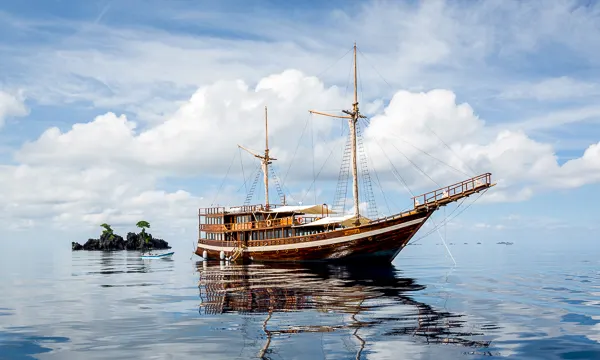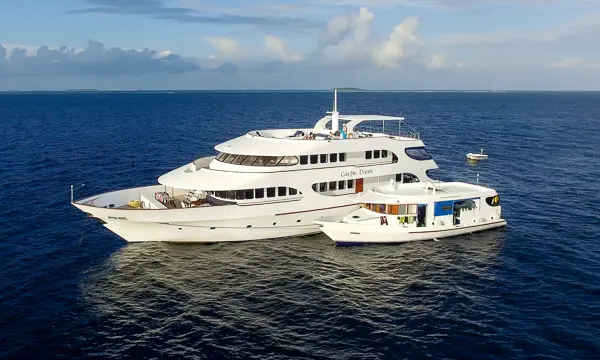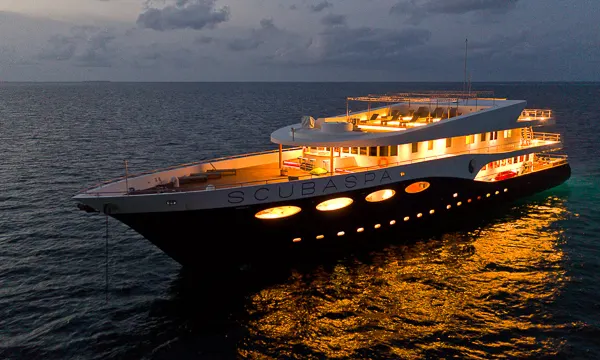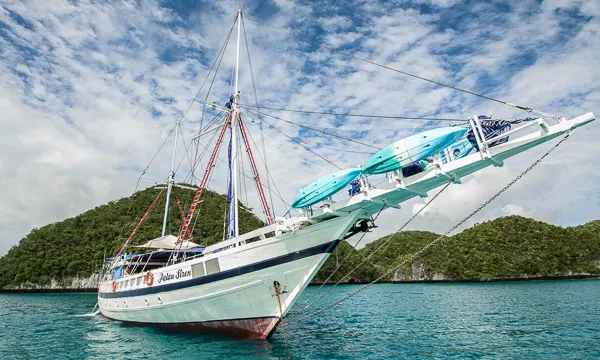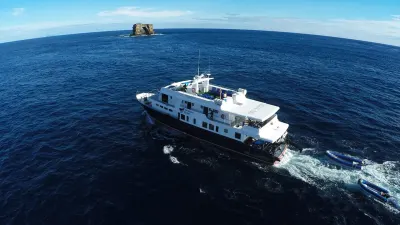Liveaboards give scuba divers the opportunity to explore massive geographic regions in a single trip - unlike staying at a dive resort. Normally delivering “best of” experiences in a particular destination, these dive safaris include more diving compared to a resort stay, as well as opportunities to explore remote areas that are simply inaccessible to day boats. But, there are some itineraries that go a step beyond! In fact, these voyages are so special, they can only be described as once-in-a-lifetime experiences!
So, if you're searching for the world's ultimate liveaboard trips and itineraries, you've come to the right place. Read on to discover the very best liveaboard trips across the globe, chosen by ZuBlu's team of dive travel experts.
Never booked a liveaboard trip before? Consider checking out our ultimate guide to liveaboard diving to find out all you need to know before you do.
The world's top 10 liveaboard trips
So here they are – the world's most incredible liveaboard diving itineraries, chosen by ZuBlu's team of travel experts!
Sail Raja Ampat's secluded south on a liveaboard to Misool

Located in southern Raja Ampat, the centre of Southeast Asia’s Coral Triangle, Misool is home to some of the most pristine coral reefs on planet earth. It’s also Indonesia’s capital of eco-tourism, with a huge protected area created and maintained by Misool Eco Resort. Liveaboard diving in Misool blends luxury with environmental responsibility, whilst bringing guests up close and personal with incredible animals like oceanic manta rays, pygmy seahorses, and the famous epaulette walking shark!
The Misool Marine Reserve encompasses a protected marine area twice the size of Singapore. Hidden beneath its turquoise bays, divers can explore towering pinnacles and current-swept ridges blanketed in soft coral. This area is known for strong currents, so be prepared to use a few advanced techniques like negative descent. Most liveaboards that explore Misool begin and end in Sorong, so you’ll also have the opportunity to explore other famous areas in Raja Ampat – including the Dampier Strait, Waigeo and other northern destinations.
- Best for – Sustainable tourism
- Best time – October to April
Join an epic liveaboard adventure across Indonesia's Banda Sea

One of the wildest liveaboard adventures on planet earth, this itinerary offers a highlight reel of Indonesia’s very best diving. Trips across the Banda Sea last a minimum of ten days, with some offering up to 18 days on the water, traversing hundreds of kilometres of remote, open water. These exclusive itineraries are typically only offered twice a year, during April and May, then again in October and November, when conditions are suitable and liveaboards make their seasonal moves between Komodo and Raja Ampat.
During a Banda Sea crossing, you’ll experience a wide variety of diving conditions, from ripping currents and blue water adventures amid schools of hammerheads, to muck diving and laid back reef exploration in colourful coral gardens. Other highlights include active volcanoes, sea snake aggregations, mating mandarinfish, and a glimpse into the region’s spice trade history. Liveaboard trips across the Banda Sea can start and end in a variety of ports, including the muck diving hub of Ambon, Raja Ampat’s primary anchorage of Sorong, and Maumere, the eastern gateway to Komodo.
- Best for – Extended adventures
- Best time – September to October
Manta mayhem on a liveaboard to the Maldives' northern atolls

Imagine yourself surrounded by scores of reef manta rays, swooping, diving, and barrel rolling all around you. If that doesn’t scream trip of a lifetime, what does? Hanifaru Bay is one of the only places on planet earth where you can witness this phenomenon, and it’s a highlight on Baa Atoll liveaboard itinerary during the season. Most of the vessels that visit Hanifaru spend a week or more at sea, giving visitors the chance to visit the bay, as well as dive the atoll’s channels and thilas.
The manta rays congregate in the bay between July and October, and, if possible, visit around a new or full moon to get the best chance of encountering large groups of rays, and even whale sharks! It’s also important to keep in mind that no scuba diving is allowed inside Hanifaru – just snorkelling. But dedicated divers don’t despair! Baa Atoll is typically combined with other atolls, famous for channel dives, coral reefs, and even whale sharks for a “best of” experience. So, you definitely won’t spend all your time snorkelling!
- Best for – Mantas and whale sharks
- Best time – July to October
Search for sharks from a liveaboard in the Maldives' deep south

While most of the Maldives is famous for five-star luxury and all-inclusive resorts, the deep south does things differently. Atolls like Fuvahmulah and Addu instead opt for a more down to earth experience, with authentic local culture, far less tourist development, and surprising year-round wildlife encounters. Not to mention the Maldives’ biggest shipwreck and a handful of sites with shark diving that’s so good you’ll have to see it to believe it!
The remote location of these atolls and dive sites, means that most deep south liveaboard itineraries last a bit longer, between 8-14 days. But, the extra time spent at sea is well worth your while! You’ll likely encounter tiger sharks, hammerheads, giant oceanic mantas, and even threshers – if you’re lucky. And, these coral atolls are just as lovely as the north, with sparkling turquoise bays and endless stretches of footprint-free white sand. Many deep south itineraries depart from Male and head south, allowing visitors easy access to less visited southern atolls like Thaa, Laamu, Meemu, and Dhaalu.
- Best for – Off the beaten path exploration
- Best time – December to May
Combine diving in north and south Komodo with a liveaboard

Famous for its fast-paced currents, close-ups with reef manta rays, pink beaches, and namesake lizards, Komodo is one of the planet’s most exciting liveaboard diving destinations. It’s also one of the most affordable! Many boats in this region offer budget-friendly shared cabins and a fun social setting onboard with a family-style ambience, ideal for outgoing guests.
Komodo is divided into two regions – north and south. The north has crystal clear water, vibrant reefs, and ripping currents. The south, by contrast, has colder water and less visibility thanks to deep-sea upwellings packed with plankton – meaning vibrant soft corals and diverse critters. This also makes it one of the planet’s best places to spot manta rays! For the best of both worlds, look for combination liveaboard trips in Komodo lasting eight days or longer and diving in both regions. Or, opt for an extended journey combining Komodo with other ports of call like Maumere to the east, or heading back west to Bali.
- Best for – Budget travel
- Best time – October to December
Frontier liveaboard diving at the far-flung reefs of Tubbataha

The remote and isolated Tubbataha Reef is often regarded as the best liveaboard diving in the Philippines. Lying well off the beaten path in the centre of the Sulu Sea, this far-flung region can only be reached when the seasons and weather permit. This limits liveaboard trips in Tubbataha to roughly four months out of the year, from March through June. It takes roughly 12 to 15 hours to make the crossing to Tubbataha with perfect conditions – though that number can easily climb to 20.
This is the largest marine park in the Philippines, and the first of its kind, covering over 130,000 hectares. The protected area encompasses two coral atolls and the smaller Jessie Beazley Reef. Perched atop a string of extinct volcanoes, the dive sites here boast incredibly steep walls, many of which drop off to 100-metres or more. In addition to these dizzying drop-offs, divers can expect vast sloping underwater gardens home to half the planet’s species of hard and soft coral, with more than 600 fish species, 11 kinds of sharks, over a dozen different dolphins and whales. If you want to take this already incredible itinerary to the next level, jump on a seasonal transition voyage. These trips combine Visayas, Tubbataha, and a few hidden gems in between!
- Best for – Exclusive adventures
- Best time – March to June
Sail to the pelagic-packed islands of Socorro on a liveaboard

Due to its tongue twister of a name, the Revillagigedo Archipelago is more commonly known as Socorro, after its most famous island. Liveaboard trips to Socorro typically depart from, and return to, Cabo San Lucas, at the southern tip of Baja California. This remote volcanic island chain takes a staggering 24 hours to reach by boat, making it one of the planet’s farthest-flung liveaboard-only dive destinations. But, divers who make this epic journey will be handsomely rewarded! Socorro's liveaboard diving is famous for big currents, big fish, and unexpected marine life encounters of all kinds. In fact, the high probability of seeing something improbable is one of this destination’s defining characteristics.
Socorro is dominated by plummeting walls, fish-filled currents, and craggy volcanic reefs. Divers here can expect once-in-a-lifetime underwater sightings of all kinds, from towering bait balls, and various whales to giant oceanic manta rays, friendly bottlenose dolphins and up to ten shark species. And, with just a handful of boats touring the islands and absolutely no day trips, you’re guaranteed uncrowded dive sites and intimate scuba experiences in one of the world’s wildest diving areas.
- Best for – The ultimate pelagic experience
- Best time – November to January
Meet schooling hammerheads on a liveaboard trip to Malpelo

Part of the recently announced Cocos-Galapagos Swimway, Malpelo is one of the Eastern Pacific’s epicentres for marine biodiversity. It’s also been called the shark diving capital of the world, thanks to a variety of incredible encounters not experienced elsewhere. Lucky dive groups might encounter the ferocious-looking yet surprisingly docile smalltooth sand tiger, as well as hammerheads and silky sharks schooling by the hundred. Chance sightings of whale sharks and giant oceanic manta rays are also common.
Malpelo is also one of the planet’s most remote liveaboard diving destinations, lying more than 500-kilometres off Colombia’s coast. It takes a whopping 30 hours by boat to get there from Buenaventura – and that’s if conditions are calm! So, most liveaboard trips to Malpelo last at least nine days. Top that off with the fact that there’s only one liveaboard currently operating in the region, and you’ve certainly got one of the most exclusive and exciting trips around! Keep in mind, Malpelo’s raging currents and ultra-remote location make it suitable for only the most advanced and adventurous explorers – no beginners allowed!
- Best for – Advanced and adventurous divers, big animals
- Best time – Year-round
Join a liveaboard trip around the unparalleled sites of Palau

Palau is easily one of the Pacific’s most exhilarating diving destinations, home to legendary sites like Blue Corner, the German Channel, and Peleliu Express – one of the world’s wildest drift dives. Visitors can also dive more than a dozen historic WWII wrecks including Japanese navy ships and planes, littered with fascinating artefacts. Palau is also a paradise for pelagics, thanks to its strong currents and proximity to deep ocean trenches. Visitors are likely to spot sharks, manta rays, and perhaps even passing whales.
Palau is spread over 300 islands, making a liveaboard the only way to truly experience the country. Most liveaboards in Palau offer “best of” itineraries, focused on fast-paced drift diving, trips to the region’s bustling cleaning stations, and plenty of wartime wrecks. Nearly every voyage also includes topside attractions in the Rock Islands, including visits to hidden lagoons, fantastic ocean kayaking, and of course, a stop at the iconic stingless jellyfish lake. For a true trip of a lifetime in this exotic destination, book a 12-day “best of” tour starting and ending in Koror.
- Best for – Wreck diving and WWII history
- Best time – October to May
Ready to start planning your next liveaboard holiday?
Speak to a dive travel experts today

ZuBlu is the leading dive travel agency to search, compare and book scuba diving travel worldwide.

